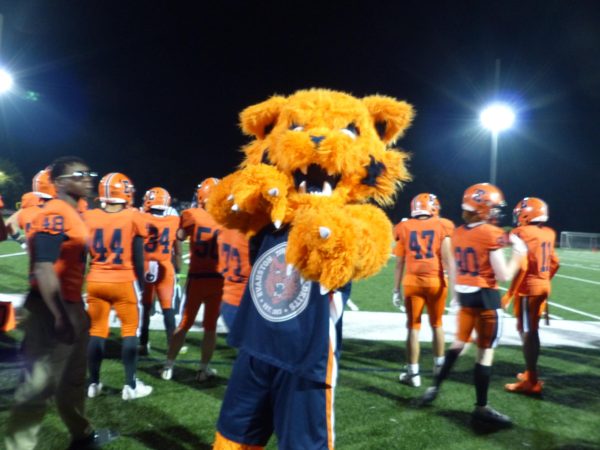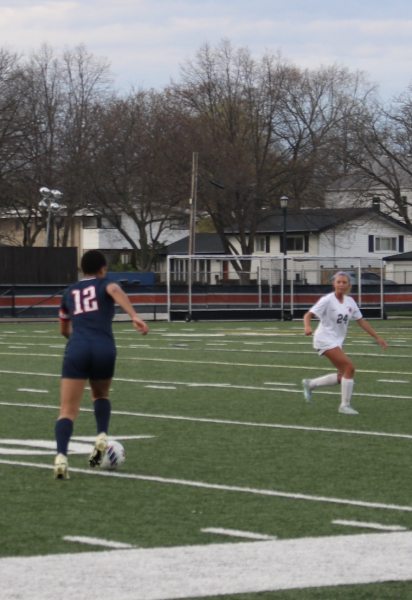‘Killing opportunities’: tackling systemic inequity in sports
December 16, 2022
The 2022 Boys Swim & Dive Senior Day was meant to be a celebration. One of the last times the team’s senior members would race at ETHS’ famed Dobbie Burton Aquatic Center, the occasion was intended to commemorate all they had worked for over the past four years.
“We all [wanted] to swim hard for our seniors, make them proud, throw on a show for our crowd,” recounts senior and current ETHS Boys Swim & Dive Captain Quintin Nguyen.
But despite all the festivities, Senior Day 2022 would instead go on to be remembered for something very different. At the end of the meet, a member of the visiting team addressed Nguyen using a racial slur, an act that unsurprisingly coincided with an unprecedented rise in hate crimes against Asian Americans nationally.
Sadly, hate speech and harassment at sporting events is nothing new. For as long as there have been organized school and youth sports in the United States, systemic bias has been ingrained into the way they have been governed, played and organized. To this day, athletes of color continue to face hostilities in their pursuit to play, and that reality is perhaps no more apparent anywhere else than at ETHS.
Something that is more new, however, are standardized policies outlining how coaches and officials at high school sporting events are to respond when hate speech arises.
“Our conference created [a] hate speech protocol for sporting events back in 2016 because of the issues that Evanson dealt with repeatedly [regarding] the use of the n-word,” says Livatino. “Slowly, other conferences asked about it. They started adopting it, and then the IHSA jumped on it after the George Floyd murder and all the other unrest that summer.”
Illinois is not the only state to have implemented such a measure in recent years. Following an incident at a boys soccer game in Vermont last fall, the Vermont Principals’ Association was prompted to begin requiring schools to read aloud a statement against hate speech before athletic events. In Massachusetts, a collaborative project between several state organizations, including the Office of the Attorney General, dedicated to combating hate in school sports was launched in April.
According to the IHSA Hate Speech and Harassment Policy and Procedure, if an official witnesses hate speech or harassment, the alleged offender is supposed to receive an immediate ejection. In the event that a referee does not bear witness to the event, however, the procedure for determining next steps looks much different, and may even allow for the alleged offender to return to competition.
“Hate speech has different ways of rearing its ugly head, but if [a student-athlete has] experienced it, [they’re] supposed to tell [their] coach. The coach would then tell [an] official. The official is supposed to stop competition right then and talk to the coach and student-athlete from the opposing team. Then, [the student-athlete has] to address whether or not they said it. If they accept, then they’re suspended immediately and are out for the next contest. If they deny, it’s basically a warning. If it happens again and the official hears it, [they’re] gone.”
Even though an alleged offender can deny having said or done anything wrong, Livatino assures that choosing to deny an allegation is never a free pass.
“Some people might think ‘Oh, they’ll just lie,’” and they might, but at the end of the day, it gets documented and it’s on file,” says Livatino. “I would get a report if one of our kids did that and then I would talk to that student-athlete. Where there’s smoke, there’s fire.
“Every year there’s some issue of hate speech, and I usually deal with two or three,” Livatino added.
Hate speech is not the only way structural racism within sports manifests itself. As varsity tennis player Sam Asaro, who is mixed race, explains people of color regularly just aren’t represented on the court.
“I’m not oblivious to it,” Asaro says. “When we play neighboring schools in our conference, I would notice. I knew to expect majority white people,” says Asaro.
Tennis is far from the only sport that has this problem. Many high school sports perpetuate racial exclusion largely as a result of two main reasons: the necessity to begin playing them well before entering high school and the sheer cost of doing so.
“I could name ten different sports where if you haven’t played before you come to ETHS, you have a zero percent chance of being an effective athlete,” says Livatino. “You might make a freshman team. You’re not going to go beyond that.”
Some of the most notable examples of these sports at Evanston include badminton, baseball, field hockey, golf, gymnastics, lacrosse, soccer, swimming, tennis, volleyball and water polo—nearly two-thirds of the sports offered by the school. While each one has its own unique set of challenges as it relates to systemic bias, the need to have experience with them as early as elementary school frequently eliminates the chance they end up being diverse in high school.
“The youth sports system and structure that’s in place right now is killing the opportunity for kids of color to get involved in sports, ever,” says Livatino.
According to the Aspen Institute, families spend an average of $883 per season for their child to play a sport. But considering the kind of athletic prowess it takes to make a varsity team at ETHS, this number is likely a stark underestimate. For some sports, individual pieces of equipment nearly meet or even exceed this number. Technical swimsuits can retail for over $600, tennis racquets may cost $250, baseball bats $500 and golf clubs possibly over $1000—and that’s just for single pieces of equipment. Once travel, team fees, uniform costs and other expenses are added in, families may be looking at sticker prices exceeding five figures. Often, this means families of color end up priced out of youth and club sports, which creates a large discrepancy in preparation and readiness for high school athletics.
“You might have the opportunity to play Haven volleyball [in sixth grade], and everybody’s kind of [on a level playing field], and those teams look relatively diverse,” says Livatino. “Then once that Haven volleyball season ends, everybody who can afford club goes off and plays club. Now, they’re getting better every single week for months at a time. The next year when they try out, it’s not the same story. By the time we get to high school, you’ve got three years on everybody else.”
Initiatives to counteract these inequities have sprung up across Evanston youth sports in recent years. For example, there’s Tennis Evolution Evanston, of which Asaro volunteers her time, and soccer club JaHbat FC, whose name is an acronym that stands for Jamaica, Americas, Haiti, Belize, Asia/Africa and Trinidad, a nod to the cultural backgrounds of the clubs founding members. On top of that, there are also a slew of student-led organizations dedicated to increasing diversity in Evanston sports. For instance, there’s Volley4Change, which was started by ETHS seniors Meg Houseworth and Margaret Adams as well as Niles West senior Cherie Animashaun and Diversify Golf, founded by sophomore Olivia Ohlson.
As Livatino shares, these are exactly the sort of programs needed to ensure that many predominantly white sports become more representative of the ETHS student body as a whole. In turn, that is also what it will take to ensure that hate speech at sporting events, similar to what Nguyen experienced, becomes a thing of the past as well.
“What it takes to change all this is youth programs that reach out systematically to bring in people from [all] races [rather] than just trying to serve whichever community can pay the fees,” says Livatino.













